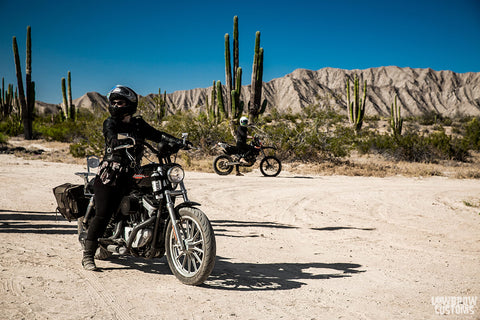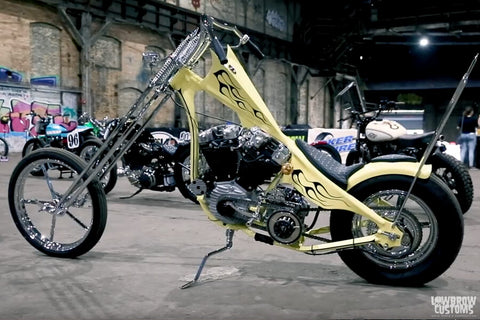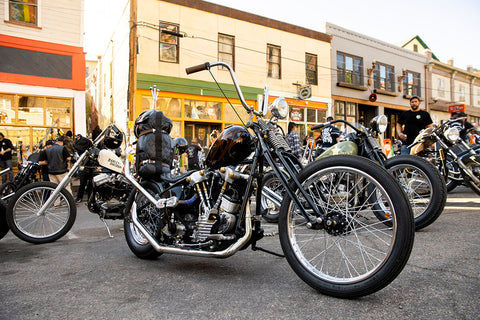- This photo shows 101st Airborne Division troops during a training exercise in England in May 1944, just prior to D-Day.
Motorcycles, Motor Scooters and the Post-War World
Motorcycles are a common sight in today’s America, and vintage motorcycles remain highly sought after to this day. We see them on the roads and highways of our nation, while owning an off-road motorbike has become a rite of passage for many teens in America. But what many people do not realize is that America’s modern love affair with vintage motorcycles came about in large part due to our involvement in the Second World War. It was in this violent crucible where many American servicemen, from fighter pilots to infantry soldiers, discovered their love for the American motorcycle.
Before the War: Motorcycles and Messengers
Even before World War II, the motorcycle was seen as a vital part of the military. As far back as 1916, sidecar-equipped motorcycles had been used by the United States during its attempts to hunt down Pancho Villa and his forces. As engine technology improved, motorcycles were increasingly seen as a modern replacement for the horse-borne infantry units that had been such an important part of the American military, with entire infantry units being equipped with motorcycles to give them greater battlefield mobility. Even so, one of their most important roles would continue to be that of providing messengers and scouts with the speed needed to do their duty on the battlefield.
 - William Harley designed some of the first ever machine gun equipped motorcycles in 1916. In the beginning utilizing side cars, this greatly improved mobility and gave a major advantage to the US Army over Mexican revolutionaries who's infantry only rode horseback in the “Border War”.
- William Harley designed some of the first ever machine gun equipped motorcycles in 1916. In the beginning utilizing side cars, this greatly improved mobility and gave a major advantage to the US Army over Mexican revolutionaries who's infantry only rode horseback in the “Border War”.Motorcycles During the Second World War
During the Second World War, motorcycles were seen by all nations as an easy way to grant the infantryman and scout mobility in a small and easily transported package. This was especially important for paratroop and airborne units, which were highly limited in what gear they could transport into enemy territory. Throughout the war, both Allied and Axis forces deployed motorcycles in every theater of the conflict.

- Motorcycles generally lead the pack in a military convo during World War II
World War II motorcycles were used in a wide variety of missions. Motorcycle-borne messengers proved to be a vital part of ensuring that messages could be quickly delivered, especially when jamming or atmospheric disturbances made radio unreliable. In other cases, sidecar-equipped motorcycles were used to transport cargo, infantry or injured soldiers.
In addition, motorcycles were commonly used to escort convoys and assist with scouting operations, although the prevalence of jeeps and armored vehicles in WWII made the use of motorcycles in direct combat options far less common than it had been in the First World War. Even so, the fact that the Harley-Davidson WLA so commonly escorted convoys through Europe saw the motorcycle being coined the “Liberator” by many admiring European civilians.
On the Eastern Front, both Russian and German forces made extensive use of motorcycles in and out of combat. In fact, so many WLA bikes were used by the USSR that Russia became an important post-war source of spare parts for American WLA motorcycle owners.
German Motorcycles: The BMW R75
Germany made extensive use of motorcycles during the Second World War and one of the nation’s most commonly used motorcycles was the BMW R75, replacing the earlier BMW R71. Powered by an OHV 750 cc engine, the R75 proved to be highly reliable in the field and was extremely popular with its operators.
In addition, a sidecar with a driven wheel using a locking differential gave the bike impressive maneuverability on all types of terrain. The sidecar itself had a number of variant designs, ranging from a passenger sidecar to cargo carriers for equipment and weapons. In many cases, the impressive MG34 general purpose machine gun was mounted on the sidecar in order to provide the driver and passenger with an anti-infantry capability.
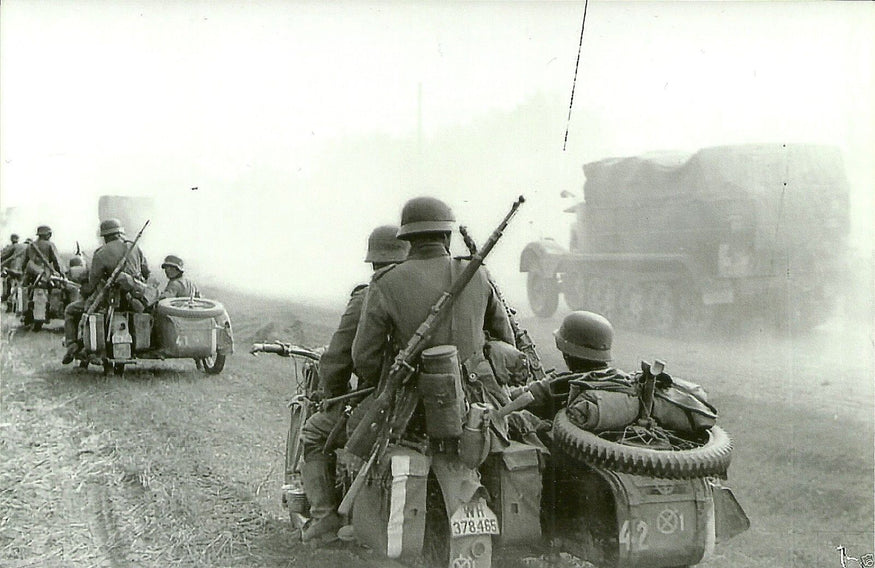 - BMW R75 carried troops and cargo on all kinds of terrain.
- BMW R75 carried troops and cargo on all kinds of terrain.
By the time the war ended, over 16,000 of these vehicles had been created. Sadly for motorcycle enthusiasts, most of them were lost in the conflict, especially during the cataclysmic engagements on the Eastern Front. However, surviving examples of the BMW R75 are prized by collectors and perhaps more tellingly, these vintage motorcycles can still hold their own with modern bikes, both on and off the highway.
Ironically, one of the greatest compliments to the BMW R75’s workmanship was provided by the victorious Soviet Union. In 1954, the USSR assembled a number of R75s in East Germany in order to evaluate them for possible use by the USSR’s forces. In fact, the Soviet Union’s wartime M-72 motorcycle had itself been based on the R71, a predecessor to the R75.
American Motorcycles: The Harley-Davidson WLA
One of the primary American contributions to the wartime motorcycle designs, the Harley-Davidson WLA was designed for a different role than the BMW R75. Unlike the German design, the WLA did not have an integral sidecar design and was mostly used by a single operator. In part, this was due to the rapid rise of the jeep, which took on many of the former duties of sidecar-equipped motorcycles. The American military also preferred to maintain the motorcycle's maneuverability by utilizing saddlebags instead of sidecars for transportation of important messages, scouting reports, or other light cargo.
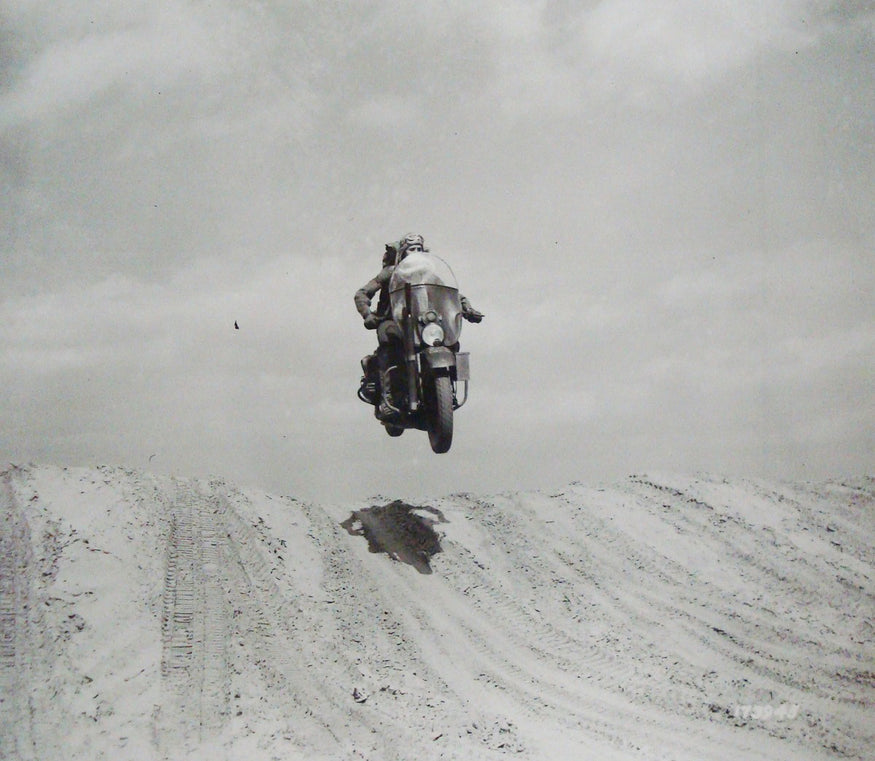 - The war was extremely hard but troops found ways to have some fun with the WLA in field trials.
- The war was extremely hard but troops found ways to have some fun with the WLA in field trials.
The primary use for the motorcycle in American service was as a messenger, transporting vital orders and packages that could not effectively be transmitted by radio. In addition, WLAs were used to escort convoys and provide scouting services for infantry units. Military police (MP) units found the motorcycles especially useful as they gave individual MPs the mobility they needed to cover large areas as the allied armies continued to advance.
Later in the war, the United States captured examples of the more sophisticated German R71. The Harley-Davidson company took the best design features from the German motorcycles in order to create the cutting edge Harley-Davidson XA. However, by that time the jeep had increasingly eclipsed the need for new motorcycle designs and fewer than 1,000 of this model had been produced by the end of the war, although several design features of the XA would live on in later Harley-Davidson products. The XA is one of the most sought after vintage Harley-Davidson motorcycles in the post-war era.
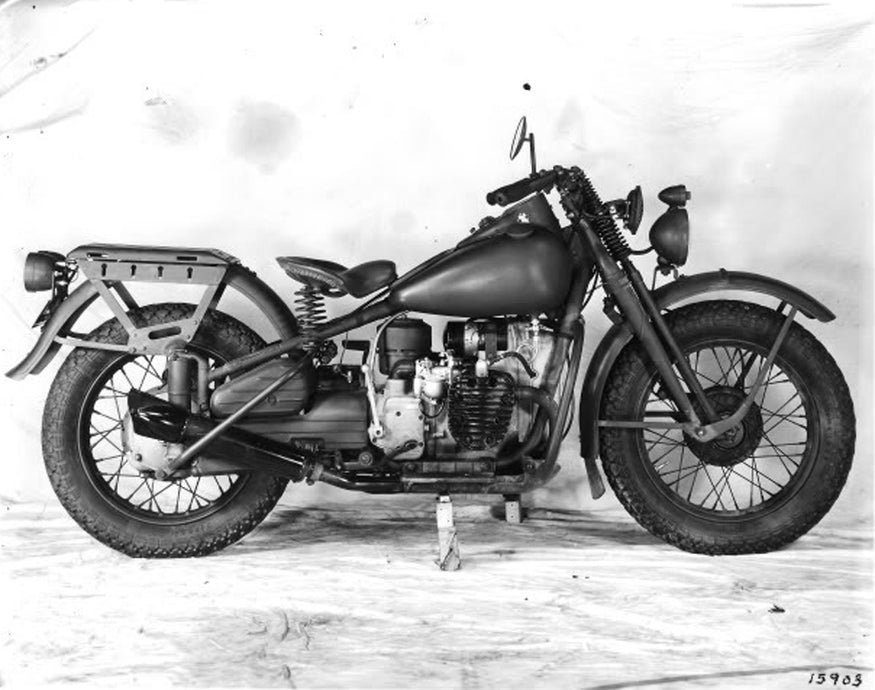 - The XA was designed by Harley-Davidson, they modeled it after the advantages of the German BMW R71. With a 45 cubic inch \ opposed twin motor with a foot shift four speed trans so troops could keep both hands on the bars. The motor stayed cooler then a WLA along with having a larger gas tank for extended range.
- The XA was designed by Harley-Davidson, they modeled it after the advantages of the German BMW R71. With a 45 cubic inch \ opposed twin motor with a foot shift four speed trans so troops could keep both hands on the bars. The motor stayed cooler then a WLA along with having a larger gas tank for extended range.The Post-War Motorcycle Era in Europe
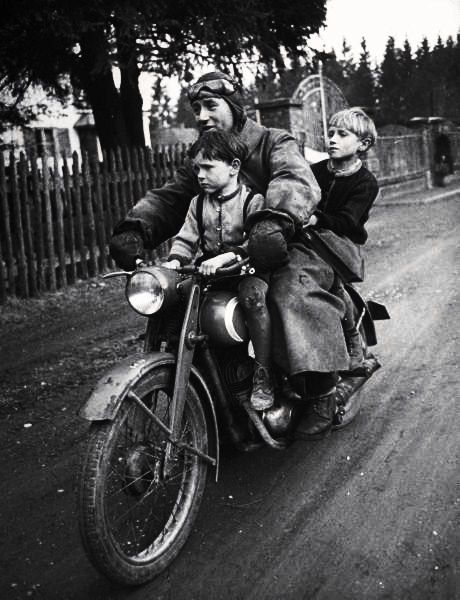 - Photo by Walter Sanders. Munich, Germany, May 1949 of a man and his two boys riding on their daily commute.
- Photo by Walter Sanders. Munich, Germany, May 1949 of a man and his two boys riding on their daily commute.
The post-war era saw American and European motorcycle development diverge to suit their differing social and economic situation. In Europe, motorcycle makers focused more on creating cheap and effective transport for a continent that had seen much of its industry destroyed during the war.
For example, by 1950 the Italian manufacturer Piaggio was selling over 60,000 Vespa motor scooters a year in Europe. For that reason, European motor scooters and motorcycles were seen in a more mundane light than their American cousins were. While cars would become more common in Europe as the economic damage wrought by the Second World War faded into the past, motorcycles and motor scooters remained a popular form of transport for everyone from deliverymen to students.
Even today, the image of an Italian or German student zooming through traffic on a motor scooter is an iconic vision of European motorcycle culture. Most importantly, European motorcycle usage never became identified with the outlaw lifestyle in the way that many American motorcycle clubs and gangs were.
Motorcycles, Veterans and America in the Post-War Era
In America, the primary driver for the rise of the motorcycle was not economic but rather based on America’s changing post-war culture. Unlike Europe, America had suffered no wartime damage and enjoyed an economic boom through most of the post-war era. The vast Detroit auto factories, no longer producing tanks and trucks for the military, had no problem producing a horde of inexpensive cars for America’s growing population and business world.
For this reason, motorcycles were not seen in the same workaday light that European motorcycles and motor scooters were seen in. Instead, they were seen as a social and personal statement and this caused American motorcycle history to play out rather differently than it did in Europe.
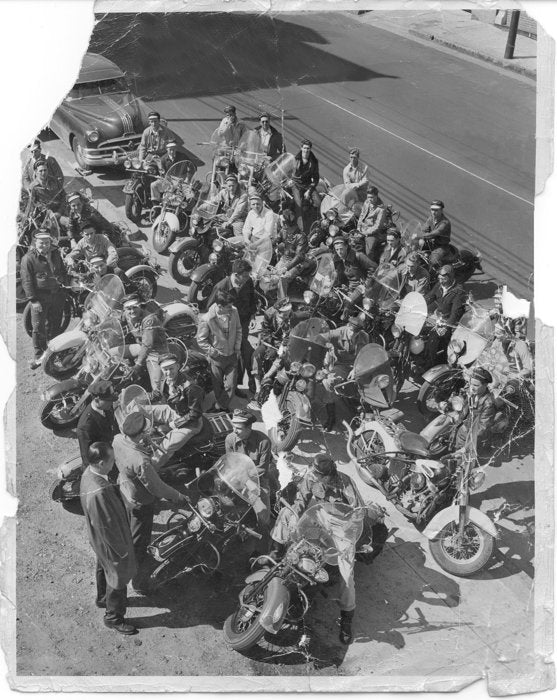 - "Gene" T.E. Key and Al McAlexander - Memphis Motorcycle Club, 1950
- "Gene" T.E. Key and Al McAlexander - Memphis Motorcycle Club, 1950
While some motorcycle clubs had existed before World War II, two factors resulted in their explosion after the war. The first was the vast number of war surplus motorcycles that were now available for a very low price due to the demobilization of much of the American military.
In some cases, former soldiers brought back the very motorcycles they had used in the war. In other cases, former soldiers purchased newly built and never used motorcycles at near scrap prices. Because of this, motorcycle clubs in America were open to a wide range of individuals, without the barrier of a high-priced bike standing in the way of a veteran’s hopes.
Secondly, many former soldiers found themselves having difficulty fitting into a peacetime world. In many cases, they craved both the excitement and sense of camaraderie that they had known during their service. A motorcycle provided them with independence and excitement as they explored America’s roads while the growth of motorcycle clubs and gangs provided them with the same wartime camaraderie that they now craved. It is likely that at least part of this drive was due to what is known today as Post Traumatic Stress Disorder (PTSD), which at the time was not well understood and was also subject to a great deal of social prejudice.
By associating with other veterans, these new bikers could gain the social support of a group who understood each other in a way that few others could. In another reflection of their wartime experiences, active motorcycle riders in America were overwhelmingly male.
The Rise of Modified Motorcycles
 - Racers would customize their bikes by taking off stock parts to reduce weight. Racing in 1949 - Photo from Porky Johnson/Museum of San Fernando Valley.
- Racers would customize their bikes by taking off stock parts to reduce weight. Racing in 1949 - Photo from Porky Johnson/Museum of San Fernando Valley.
Motorcycle riders in America quickly put their own unique stamp on motorcycle culture. War surplus and newly manufactured bikes alike soon found themselves modified to better suit their riders’ needs and desires. Although the history of bobbers, or motorcycles modified to remove unneeded weight by stripping off parts of the frame and “bobbing” the rear fender, had extended from before World War II, this practice entered its glory days in the post-war era.
Removing extra weight improved speed and performance while adding decorative touches such as chrome plating and various types of paint jobs allowed the owner to customize the motorcycle to suit his own desires. In fact, it was not until the 1990s that bobbers became commercially available, as opposed to being unique to each individual motorcycle.
Motorcycle Clubs and Gangs
The motorcycle clubs that formed after World War II were quite different from the ones that had existed in the pre-war era. The American Motorcyclist Association (AMA) had been founded in 1924 and focused on promoting a professional and family friendly image. But in the post-war era, more than a few of the new motorcycle enthusiast chafed at some of those restrictions and in the aftermath of the 1947 Hollister Riot, a growing number of bikers ignored the AMA, becoming known as Outlaw Motorcycle Gangs (OMGs).
In addition, a (possibly apocryphal) statement from the AMA claimed that the riot had been caused by only one percent of the bikers present, leading to some groups identifying themselves as the “one-percenters.”
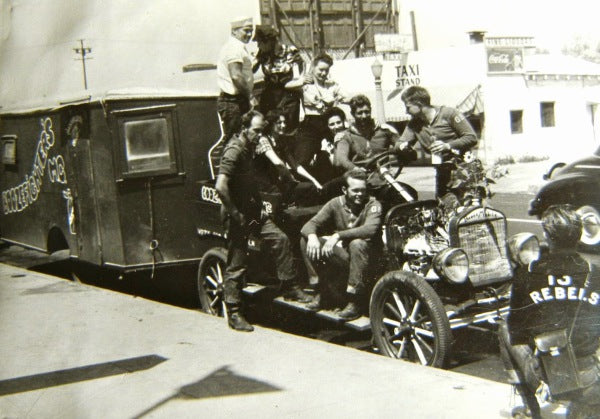 - The Boozefighters were almost entirely made up of WWII vets in the beginning. In 1947 The Boozefighters put "Motorcycle Clubs" on the map after an extremely hyped and over dramatized media coverage of a riot in Hollister, CA.
- The Boozefighters were almost entirely made up of WWII vets in the beginning. In 1947 The Boozefighters put "Motorcycle Clubs" on the map after an extremely hyped and over dramatized media coverage of a riot in Hollister, CA.Finally, it should be noted that the impact of Hollister Riot had been blown far out of proportion by irresponsible media attention, turning what was in truth a rather raucous street party into a major riot in the public eye. This negative media attention would continue to present a problem for motorcycle enthusiasts from the 1940s all the way to the present day. The vast majority of these OMGs were not made up of criminals but merely identified themselves as being unwilling to accept AMA restrictions on their actions. In addition, because the AMA did not permit non-white members to join until the 1950s, minority motorcycle enthusiasts had no choice but to remain apart from the AMA.
However, some groups did find themselves becoming involved in criminal activities. Any post-war examination of how motorcycle gangs started will note that many motorcycle clubs that have been associated with criminal activity by the public and law enforcement, such as the Hells Angels, can be seen as an offshoot of the growth of OMGs and one-percenters in the aftermath of Hollister.
Unfortunately, the opinion that all motorcyclists were potentially dangerous criminals had become more or less fixed in the American society by the early 1950s. This attitude was also promoted by numerous movies showing motorcycle enthusiasts in a negative light, such as the 1953 film, The Wild One.
The Motorcycle and the Legacy of World War II
Today, motorcycles have become an integral part of our life, from organized AMA clubs to individuals who navigate our crowded freeways with the freedom that only a motorcycle can bring. But we should remember that the popularity of the American motorcycle was forged in the cauldron of the Second World War. Without those events and the way so many of the greatest generation fell in love with the freedom the motorcycle represented, our nation’s love affair with the motorcycle may never have come about. World War II’s motorcycles did not simply carry America’s soldiers to victory from North Africa to France; they also helped to transform post-war motorcycle culture in America.
Related Products







